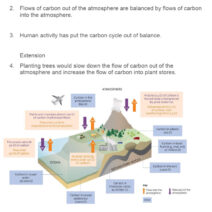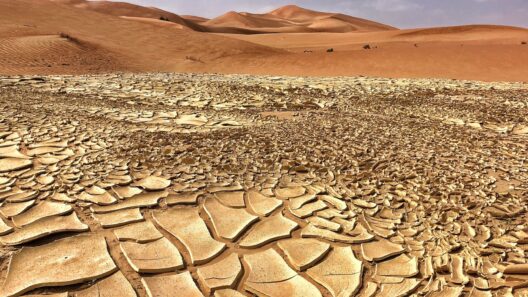Climate change is no longer a distant specter looming on the horizon; it has become an urgent reality that demands immediate action. Human actions over the past centuries have significantly altered the delicate balance of our planet’s ecosystems, resulting in profound and deleterious effects. The science is unequivocal: our activities have unleashed unprecedented levels of greenhouse gases into the atmosphere. This comprehensive examination seeks to illuminate the myriad ways in which our actions contribute to climate change and underscores the critical need for a paradigm shift in our behaviors and policies.
To comprehend the impact of human actions, we must first grapple with the fundamental processes that govern climate change. The Earth’s climate system is intricately intertwined with the concentrations of greenhouse gases such as carbon dioxide (CO2), methane (CH4), and nitrous oxide (N2O). These gases, naturally occurring in the atmosphere, are essential for trapping heat and maintaining a habitable climate. However, industrialization, deforestation, and unsustainable agricultural practices have exponentially increased the emissions of these gases, intensifying the greenhouse effect and leading to global warming.
One of the primary culprits in the rise of greenhouse gases is the burning of fossil fuels. As societies have evolved, reliance on coal, oil, and natural gas for energy has skyrocketed. Transportation, electricity generation, and industrial manufacturing are heavily fossil fuel-dependent, contributing approximately 75% of total global greenhouse gas emissions. The combustion of these energy sources releases vast quantities of CO2, which remains in the atmosphere for centuries, exacerbating the warming trend.
Additionally, deforestation plays a pivotal role in climate change. Forests serve as carbon sinks, absorbing CO2 from the atmosphere and storing it in biomass and soil. However, human activities such as logging, land conversion for agriculture, and urbanization lead to significant tree loss. The Food and Agriculture Organization (FAO) estimates that approximately 10 million hectares of forest are lost each year, releasing an estimated 1.1 billion tons of CO2 into the atmosphere. This destruction not only diminishes our planet’s ability to sequester carbon but also disrupts entire ecosystems, leading to biodiversity loss and habitat degradation.
Moreover, agricultural practices significantly contribute to climate change. Intensive farming techniques reliant on synthetic fertilizers and monoculture crops lead to soil degradation, water depletion, and increased emissions of nitrous oxide—a greenhouse gas with a global warming potential 298 times greater than CO2 over a 100-year period. Livestock farming is another major contributor, as methane emitted from enteric fermentation during digestion is a powerful greenhouse gas. As global demand for meat and dairy products skyrockets, so too do the environmental costs associated with livestock production.
Industrial waste and pollution are additional factors exacerbating climate change. Industries generate vast amounts of waste, much of which is inadequately managed and can release harmful chemicals and gases into the atmosphere. The manufacturing process itself often relies on energy generated from fossil fuels, thus compounding emissions. Moreover, the globalization of supply chains means that pollution and emissions are frequently displaced to developing nations, where regulatory standards may be lax or entirely absent.
Urbanization further amplifies the climate crisis. As the global population shifts towards urban centers, cities grappling with increased energy consumption and vehicle emissions contribute significantly to greenhouse gas emissions. Concrete and asphalt absorb heat, contributing to the phenomenon known as the urban heat island effect, whereby urban areas experience higher temperatures than their rural counterparts. Urban planning that prioritizes sustainable transportation, green spaces, and energy-efficient buildings is essential to mitigate these effects.
The interplay of these factors reveals a complex web of interdependencies: human activities not only drive climate change but also exacerbate its effects, leading to a cycle of environmental destabilization. The consequences are severe and all-encompassing, ranging from rising sea levels, extreme weather events, and shifting ecosystems, to impacts on food security and public health. Natural disasters spurred by climate change are more frequent and intense than ever, placing humanitarian systems under unprecedented strain and jeopardizing livelihoods across the globe.
Yet, amidst this dire landscape, there lies a profound opportunity for transformation. A shift in perspective and commitment to sustainable practices can alter the trajectory of climate change. Transitioning to renewable energy sources, such as solar, wind, and hydroelectric power, is paramount. These alternatives reduce dependency on fossil fuels and generate far fewer emissions. Implementing energy-efficient technologies in homes and industries also contributes to significant reductions in energy consumption and greenhouse gases.
Reforestation and afforestation initiatives can restore the earth’s capacity to absorb carbon. Protecting existing forests and restoring degraded lands, combined with innovative agricultural practices such as permaculture, can develop a resilient food system while sequestering carbon in natural ecosystems. Urban areas must embrace sustainable design principles, promoting public transportation, green architecture, and urban forests to create environments conducive to human wellbeing while mitigating climate impacts.
Finally, addressing climate change necessitates collective action, including international cooperation and policy reform. Countries must collaborate to commit to stringent emissions reduction targets while transitioning to sustainable economies. Grassroots activism, informed consumer choices, and education can empower individuals and communities to demand accountability and advocate for systemic change.
A wake-up call resounds across the globe. The connection between human actions and climate change is undeniable, and the time to act is now. By understanding our role in perpetuating this crisis, we can harness our collective capacity to reverse the tide. Embracing sustainable practices not only preserves the planet for future generations but also cultivates a healthier, more equitable world. Together, we can forge a sustainable future—one action at a time.







